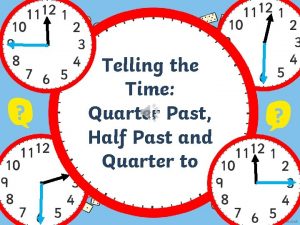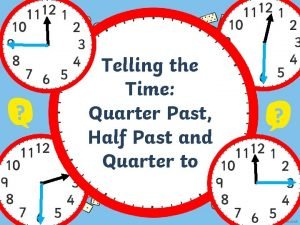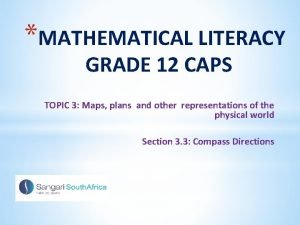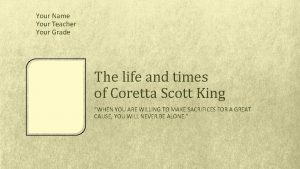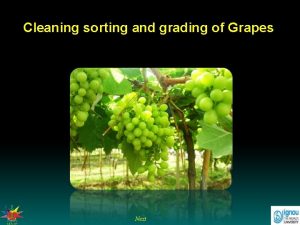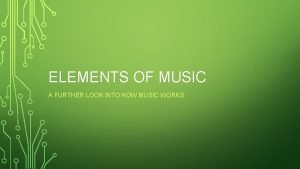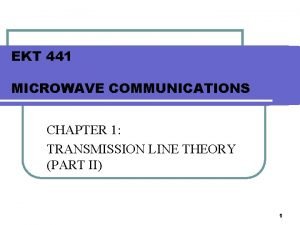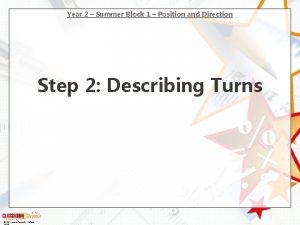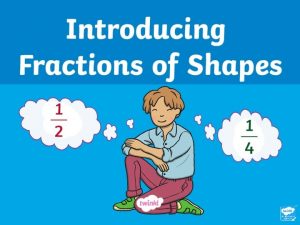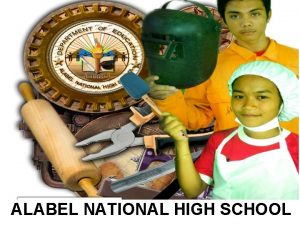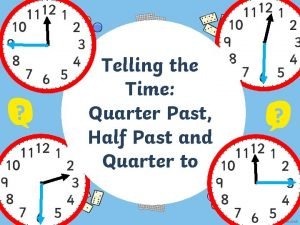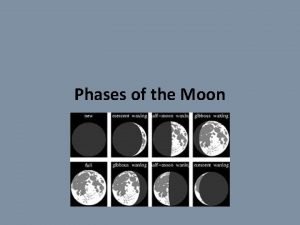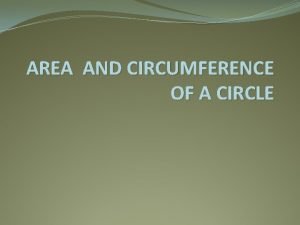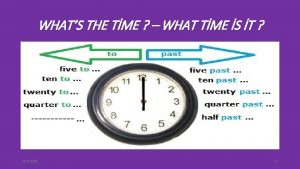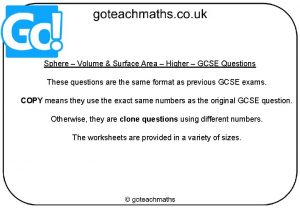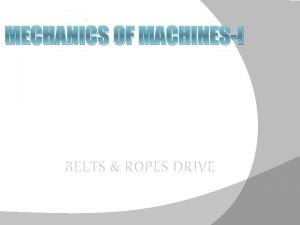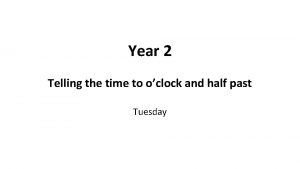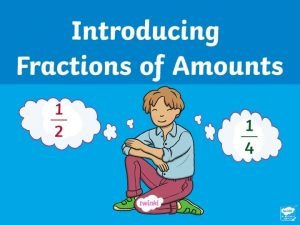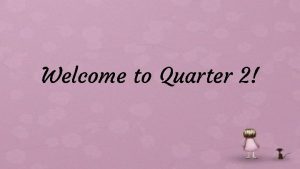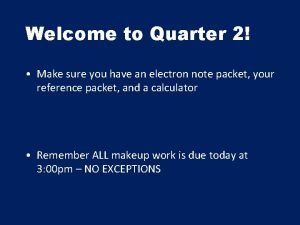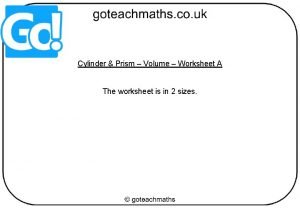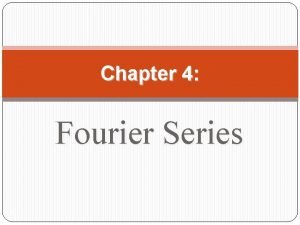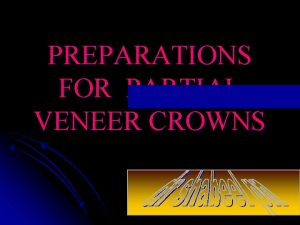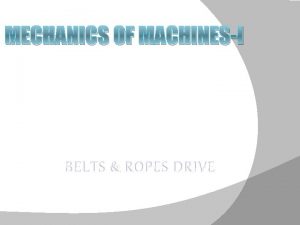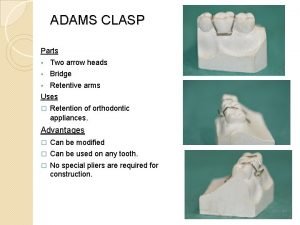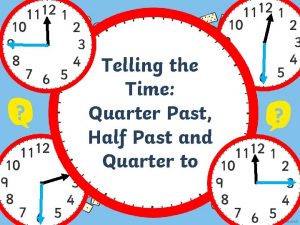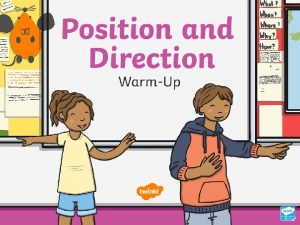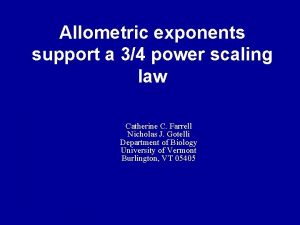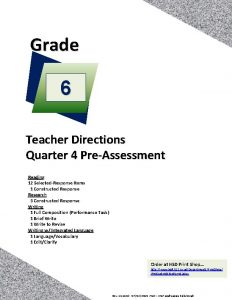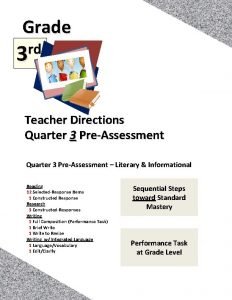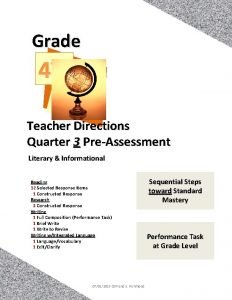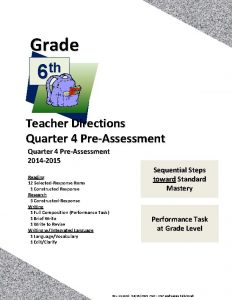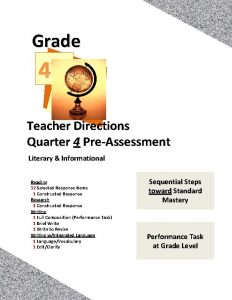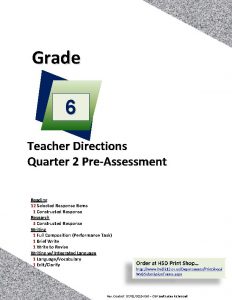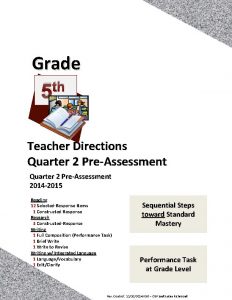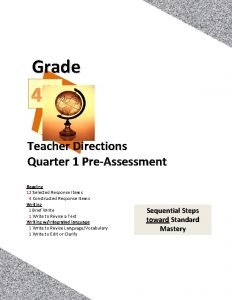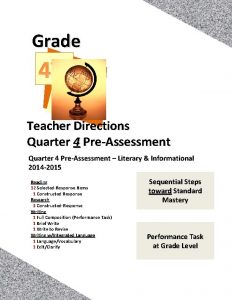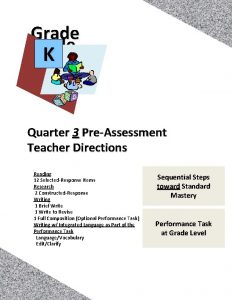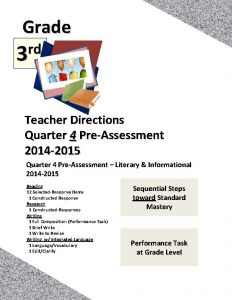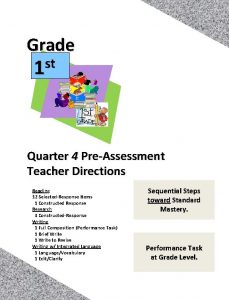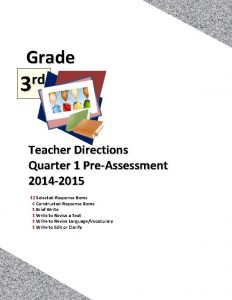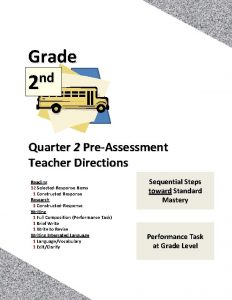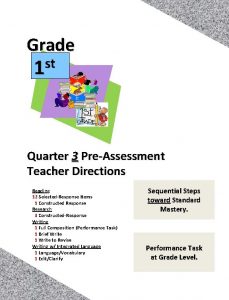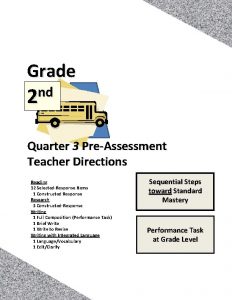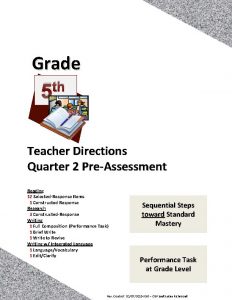Grade st 1 Quarter 2 PreAssessment Teacher Directions







![Animal Adaptations Classroom Activity continued… [Show picture of the polar bear] Facilitator says: “With Animal Adaptations Classroom Activity continued… [Show picture of the polar bear] Facilitator says: “With](https://slidetodoc.com/presentation_image_h2/2122849f531b0bdc6cae7b22b98de295/image-8.jpg)




































- Slides: 44

Grade st 1 Quarter 2 Pre‐Assessment Teacher Directions Reading 12 Selected‐Response Items 1 Constructed Response Research 3 Constructed‐Response Writing 1 Full Composition (Performance Task) 1 Brief Write 1 Write to Revise Writing w/ Integrated Language 1 Language/Vocabulary 1 Edit/Clarify Sequential Steps toward Standard Mastery. Performance Task at Grade Level.

st 1 Quarter Two Pre-Assessment Reading: Literature Targets Standards DOK 4 Reasoning & Evaluation RL. 6 3‐ 4 5 Analysis Within or Across Texts RL. 6, RL. 7 3‐ 4 6 Text Structures/Features RL. 5 2‐ 3 Reading: Informational Targets Standards DOK 4 Reasoning & Evaluation RI. 6 3‐ 4 5 Analysis Within or Across Texts RI. 7 2‐ 3 6 Text Structures/Features Rl. 5, RI. 7 2 Note: There may be more standards per target. Actual assessed writing standards are boxed. Informational Writing and Language Targets Standards DOK 3 a Brief Informational Write W. 2 a, W. 2 b, W. 2 c, and/or W. 9 3 3 b Write‐Revise Informational W. 2 a, W. 2 b, W. 2 c and/or W. 9 2 4 Full Informational Composition W‐ 2 a, W‐ 2 b, W‐ 2 c, W‐ 3 b, W‐ 4, W‐ 5, W‐ 8, W‐ 9 4 8 Language‐Vocabulary Use L. 1. 5 d 1‐ 2 9 Edit and Clarify L. 1. 2 c 1‐ 2

All elementary ELA assessments were reviewed and revised in June of 2015 by the following amazing and dedicated HSD K‐ 6 th grade teachers. Deborah Alvarado Lincoln Street Ko Kagawa Minter Bridge Linda Benson West Union Jamie Lentz Mooberry Anne Berg Eastwood Sandra Maines Quatama Aliceson Brandt Eastwood Gina Mc. Lain TOSA Sharon Carlson Minter Bridge Teresa Portinga Patterson Deborah Deplanche Patterson Judy Ramer Consultant Alicia Glasscock Imlay Sara Retzlaff Mc. Kinney Sonja Grabel Patterson Jami Rider Free Orchard Megan Harding Orenco Kelly Rooke Free Orchards Renae Iversen Teacher Mentor Angela Walsh Witch Hazel Ginger Jay Witch Hazel Performance Task Classroom Activities for K – 6 were written by Jamie Lentz, Gina Mc. Lain, Hayley Heider, Anna Wooley, Gretchen Erlandsen, Deborah Deplanche, Connie Briceno, Judy Ramer, Carrie Ellis, Sandra Maines, Renae Iversen, Anne Berg, Aliceson Brandt and Ko Kagawa. Rev. Control: 07/01/2015 HSD – OSP and Susan Richmond 3

This is a pre-assessment to measure the task of writing an informational article. Full compositions are always part of a Performance Task. A complete performance task would have: Part 1 • A Classroom Activity (30 Minutes) (35 minutes – Independent work) • Passages or stimuli to Read • 3 Research Questions • There may be other constructed response questions. Part 2 • A Full-Composition (70 Minutes) Students should have access to spell-check resources but no grammar-check resources. Students can refer back to their passages, notes and 3 research questions and any other constructed responses, as often they’d like. Directions 30 minutes 1. You may wish to have a 30 minute classroom activity. The purpose of a PT activity is to ensure that all students are familiar with the concepts of the topic and know and understand key terms (vocabulary) that are at the upper end of their grade level (words they would not normally know or are unfamiliar to their background or culture). The classroom activity DOES NOT pre-teach any of the content that will be assessed! 35 minutes 2. Students read the passages independently. If you have students who can not read the passages you may read them to those students but please make note of the accommodation. Remind students to take notes as they read. During an actual SBAC assessment students are allowed to keep their notes as a reference. 3. Students answer the 3 research questions or other constructed response questions. Students should also refer to their answers when writing their full informational piece. 15 minute break 70 Minutes 4. Students write their full composition (informational piece). SCORING An Informational Rubric is provided. Students receive three scores: 1. Organization and Purpose 2. Evidence and Elaboration 3. Conventions Rev. Control: 07/01/2015 HSD – OSP and Susan Richmond 4

Order at HSD Print Shop… http: //www. hsd. k 12. or. us/Departments/Print Shop/Web. Submission. Forms. aspx Directions The HSD Elementary assessments are neither scripted nor timed assessments. They are a tool to inform instructional decision making. It is not the intent of these assessments to have students “guess and check” answers for the sake of finishing an assessment. All students should “move toward” taking the assessments independently but many will need scaffolding strategies. If students are not reading at grade level and can’t read the text, please read the stories to the students and ask the questions. Allow students to read the parts of the text that they can. Please note the level of differentiation a student needed. About this Assessment This assessment includes: Selected-Response, Constructed-Response, and a Performance Task. Types of SBAC Constructed Response Rubrics in this Assessment http: //www. livebinders. com/play? id=774846 Reading • 2 Point Short Response • 3 Point Extended Response Writing • 4 Point Full Composition Rubric (Performance Task) • 3 Point Brief Write (1 -2 Paragraphs) Rubric • 3 Point Write to Revise Rubrics as Needed Research • 2 Point Rubrics Measuring Research Skill Use Quarter 2 Performance Task The underlined sections are those scored on SBAC. Please take 2 days to complete performance tasks. Part 1 • • Part 2 Classroom Activity if Desired/Needed Read two paired passages. Take notes while reading (note-taking). Answer SR and CR research questions about sources Components of Part 1 Note‐Taking: Students take notes as they read passages to gather information about their sources. Students are allowed to use their notes to later write a full composition (essay). Note-taking strategies should be taught as structured lessons throughout the school year in grades K – 6. A teacher’s note‐taking form with directions and a note‐taking form for your students to use for this assessment is provided, or you may use whatever formats you’ve had past success with Please have students practice using the note-taking page in this document before the actual assessment if you choose to use it. Research: In Part 1 of a performance task students answer constructed response questions written to measure a student’s ability to use research skills needed to complete a performance task. These CR questions are scored using the SBAC Research Rubrics rather than reading response rubrics. • • • Plan your essay (brainstorming -pre-writing). Write, Revise and Edit (W. 5) Writing a Full Composition or Speech Components of Part 2 Planning Students review notes and sources and plan their composition. Write, Revise and Edit Students draft, write, revise and edit their writing. Word processing tools should be available for spell check (but no grammar check). Full Written Informational Composition • introduction (identifies the topic and provides a focus) • organization (definition, classification, comparison/contrast, etc. ), • development (with facts, concrete details, quotations, other information) • transitions (linking ideas) • precise language and domain‐specific vocabulary • conclusion (closure) • Conventions of Standard English. There are NO Technology‐enhanced Items/Tasks (TE) Note: It is highly recommended that students have experiences with the following types of tasks from various on‐line instructional practice sites, as they are not on the HSD Elementary Assessments: reordering text, selecting and changing text, selecting text, and selecting from drop-down menu Rev. Control: 07/01/2015 HSD – OSP and Susan Richmond

Animal Adaptations Performance Task Classroom Activity This classroom pre-activity follows the Smarter Balanced Assessment Consortium general design of contextual elements, resources, learning goals, key terms and purpose [http: //oaksportal. org/resources/] The classroom activity was written by Gina Mc. Lain and Hayley Heider. The Classroom Activity introduces students to the context of a performance task, so they are not disadvantaged in demonstrating the skills the task intends to assess. Contextual elements include: 1. an understanding of the setting or situation in which the task is placed 2. potentially unfamiliar concepts that are associated with the scenario 3. key terms or vocabulary students will need to understand in order to meaningfully engage with and complete the performance task The Classroom Activity is also intended to generate student interest in further exploration of the key idea(s). The Classroom Activity should be easy to implement with clear instructions. Please read through the entire Classroom Activity before beginning the activity with students to ensure any classroom preparation can be completed in advance. Throughout the activity, it is permissible to pause and ask students if they have any questions. Resources needed: • • Chart paper, white board or chalkboard to make T-Chart Markers or chalk Some method of displaying ancillary materials* Colored copies of pictures Learning Goals: • Students will understand the context of the key concepts related to the topic o how animals adapt to survive Students will understand the key terms: Note: Definitions are provided here for the convenience of facilitators. Students are expected to understand these key terms in the context of the task, not memorize the definitions. • Survive • Adaptations [Purpose: The facilitator’s goal is to help students understand how animals adapt to survive. ] *Facilitators can decide whether they want to display ancillary materials using an overhead projector or computer/Smartboard, or whether they want to produce them as a handout for students.

Animal Adaptations Classroom Activity continued… Facilitator says: “Today we will get ready for the Animal Adaptations Performance Task that is about visiting penguins in Antarctica. Let’s start by discussing what we know about animal adaptations. ” Facilitator says “Does anyone know what adaptations are? ” Possible student responses: • How animals change • Kinds of animals Facilitator says: “Animal adaptations are ways in which animals change to survive. Another word for survive is live. Animals that can adapt to where they live, survive longer. ” [Draw a T‐Chart on chart paper, whiteboard or chalkboard, labeling first column “animal” and second column “adaptation”. ] Facilitator says: “I have made a T‐chart. I have included the headings “animal” and “adaptation”. Here is an example of one animal and it’s adaption. [Show picture of Chameleon] Facilitator says: “This is a chameleon. Chameleons change color to hide from predators. This adaptation is called camouflage. [On the T‐Chart, write “Chameleon” under the animal heading and “Camouflage to hide from predators” under the adaptation heading] Discussion question: • How do animals adapt to survive? Facilitator says: “Please use the following pictures to answer this question about each animal. ” [Show picture of the duck] Facilitator says: “With your partner, talk about which adaptations you think ducks use to survive. ” [Give students one minute to discuss with partners] Facilitator says: “When I call on you, I want someone to share what you discussed with your partner. ” Possible Student Responses: • Feathers to fly or float • Wings to fly • Webbed feet to swim • Beak to find food [Write student responses on the T‐Chart. If students do not come up with reasonable or relevant responses, use the examples from the possible student answers above. ]
![Animal Adaptations Classroom Activity continued Show picture of the polar bear Facilitator says With Animal Adaptations Classroom Activity continued… [Show picture of the polar bear] Facilitator says: “With](https://slidetodoc.com/presentation_image_h2/2122849f531b0bdc6cae7b22b98de295/image-8.jpg)
Animal Adaptations Classroom Activity continued… [Show picture of the polar bear] Facilitator says: “With your partner, talk about which adaptations you think polar bears use to survive. ” [Give students one minute to discuss with partners] Facilitator says: “When I call on you, I want someone to share what you discussed with your partner. ” Possible Student Answers: • White fur to camouflage • Fur to stay warm • Fat to stay warm • Strong to fight • Sharp teeth to eat • Big paws for swimming [Write student responses on the T‐Chart. If students do not come up with reasonable or relevant responses, use the examples from the possible student answers above. ] [Show picture of the penguin] Facilitator says: “With your partner, talk about which adaptations you think penguins use to survive. ” [Give students one minute to discuss with partners] Facilitator says: “When I call on you, I want someone to share what you discussed with your partner. ” Possible Student Answers: • Wings for swimming • Beaks to eat • Webbed feet to swim • Feathers to keep warm • Black and white to camouflage [Write student responses on the T‐Chart. If students do not come up with reasonable or relevant responses, use the examples from the possible student answers above. For the penguin example, please make sure you do not cite specific examples from the texts. ] Facilitator says: “In your performance task, you will be learning more about animals adaptations. The group work you did today should help prepare you for the research and writing you will be doing in the performance task. ” Note: Facilitator should collect student notes from this activity.

ancillary materials chameleon duck

ancillary materials polar bear penguin

Pre‐Assessment and Learning Progressions The pre‐assessments are very unique. They measure progress toward a standard Unlike the Common Formative Assessments which measure standard mastery, the pre-assessments are more like a base-line picture of a student’s strengths and gaps, measuring skills and concepts, students need “along the way, ” in order to achieve standard mastery. Beg. of QTR CFA Example of a Learning Progression for RL. 2. 1 Pre-Assessments Measure Adjustment Points (in purple) After the pre-assessment is given, Learning Progressions provide informal formative assessment below and near grade-level “tasks” throughout each quarter. DOK 1 ‐ Ka Recall who, what, where, when, why and how about a story read and discussed in class. DOK ‐ Kc Use and define Standard Academic Language: who, what, where, when, why, and how; ask, answer, questions, key details DOK 1 ‐ Cd Connect the terms who to characters; where and when to setting; what and how to sequence of events. DOK 1 ‐ Cf Ask and answer who, what, where, when, why and how questions about key details in a text. Throughout the QTR DOK 2 ‐ Ch Concept Development Student understands that key details help tell who, what, where, when, why and how. DOK 2 ‐ Ck Uses key details to identify who, what, where, when, why and how about a story not read in class. DOK 2 ‐Cl Finds information using key details to answer specific questions about a new story. END of QTR RL. 2. 1 grade ‐level standard assessment. Standard Mastery RL. 2. 1 Ask and answer such questions as who, what, where, when, why, and how to demonstrate understanding of key details in a text So what about a “post-assessment? ” There is not a standardized post-assessment. The true measure of how students are doing “along the way, ” is assessed in the classroom during instruction and classroom formative assessment. For this reason The CFA’s are not called “post-assessments. ” The CFAs measure the “end goal, ” or standard mastery. However, without the pre-assessments, how will we know what our instruction should focus on throughout each quarter? Learning Progressions: are the predicted set of skills needed to be able to complete the required task demand of each standard. The learning progressions were aligned to Hess’ Cognitive Rigor Matrix. The pre-assessments measure student proficiency indicated on the boxes in purple (adjustment points). These points are tasks that allow us to adjust instruction based on performance. For instance, if a student has difficulty on the first “purple” adjustment point (DOK-1, Cf) the teacher will need to go back to the tasks prior to DOK-1 Cf and scaffold instruction to close the gap, continually moving forward to the end of the learning progression. There is a Reading Learning Progression checklist for each standard in each grade that can be used to monitor progress. It is available at: http: //sresource. homestead. com/Grade-2. html Rev. Control: 07/01/2015 HSD – OSP and Susan Richmond 11

Quarter Two Reading Literature Learning Progressions. The indicated boxes highlighted before the standard, are assessed on this preassessment. The standard itself is assessed on the Common Formative Assessment (CFA) at the end of each quarter. DOK 1 ‐ Ka DOK 1 ‐ Kc Recall or locate books that tell stories and books that give informatio n. Define and use Standard Academic Language: explain, differences, major, informatio n text and “books that tell a story. ” DOK 1 ‐ Ka Retell details about characters in a story (read and discussed in class). DOK 1 ‐ Ce Use words accurately when identifying literary elements (characters, setting) and information al elements (heading, topic). DOK 1 ‐ Kc Define and use Standard Academic Language: character, setting, identify, telling, speaking and phrase “points in a text. ” DOK 1 ‐ Ka Locate illustrations in a story. DOK 1 ‐ Kc Define and use Standard Academic Recall details about Language: characters, setting illustrations, or events. story, details, describe, (read and discussed characters, in class) setting and event. DOK 1 ‐ Cf DOK 2 ‐ Ch DOK 2 ‐ Ck Answers questions about details in books that tell stories and books that give informati on (read and discussed in c lass) Content Developm ent Understan ds that books have different purposes and can give examples between books that tell stories and books that provide informatio n. DOK 1 ‐ Cd Uses correct words to explain who spoke in a text (i. e. , “___said”or“__ is telling the story now. . . ”). Identifies and describes the aspects that are different between books that tell stories and books that give informatio n. Identify text details – words – that help describe a character, setting or event. SELECTED RESPONSE Locate specific information in story books and information al books to demonstrate an understandi ng of the differences. SELECTED REPONSE DOK 1 ‐ Cf Answers questions about who is speaking in a text (that has been read and discussed in class). SELECTED RESPONSE DOK 1 ‐ Cd Identify an illustration in a story that helps describe a character, setting or event. DOK 2 ‐ Cl Using a wide range of text types, explain the major differences between books that tell stories (literary) and books that give information (information al). DOK 2 ‐ Ch Concept Development Understands that there are clues in a text to tell us when someone is speaking. Can give examples. SELECTED RESPONSE DOK 1 ‐ Cf Answer who, what, when, where and how questions about literary elements (characters, setting and events). SELECTED REPSONSE DOK 2 ‐ ANt Analyze text Distinguish structure of text a range of features text types between (both books that literary and tell stories information (literary) al) by noting and books the that give similarities informatio and n differences (informatio (using a nal) by graphic answering organizer). questions SELECTED (new text!). REPONSE DOK 2 ‐ ANp DOK 2 ‐ ANr DOK 2 –Ck Identifies different parts of a text that shows when a character is speaking (read in class, but not discussed). DOK 2 ‐ Ch Concept Development Explain how details and illustrations are used by an author to describe characters, setting or events. DOK 3 – EVC Standard Explains RL. 1. 5 why a text Explain is a story major “text” or an differences information between al text by books that citing tell stories evidence and books and that give examples information, SELECTED drawing on a RESPONSE wide reading of a range of text types (cite evidence). DOK 3 ‐ APx DOK 2 –Cl Locate information (the part of the text) to identify specifically who is telling the story at various points in a new text. CONSTRUCTED RESPONSE DOK 2 ‐ Cl Locate illustrations and details that answer specific questions about characters, setting or events. DOK 2 ‐ APn Obtain and interpret information using illustrations and details to describe characters, setting, or events. CONSTRUCTED RESPONSE Rev. Control: 07/01/2015 HSD – OSP and Susan Richmond Standard RL. 1. 6 Identify who is telling the story at various points in a text. Standard RL. 1. 7 Use illustrations and details in a story to describe its characters, setting, or events. 12

Quarter Two Reading Informational Learning Progressions. The indicated boxes highlighted before the standard, are assessed on this preassessment. The standard itself is assessed on the Common Formative Assessment (CFA) at the end of each quarter. DOK 1 ‐ Ka Locate heading, table of contents, glossaries, electronic menus, and icons in texts that have been read and discussed in class. DOK 1 ‐ Ka Locate a picture, caption or text in a story that has been read and discussed in class. DOK 1 ‐ Ka Retell parts of a story by referring to pictures or words in a text (read and discussed in class). DOK 1 ‐ Kc Define and use Standard Academic Language: text features, (e. g. , heading, table of contents, glossary, electronic menu, icon), “key fact”, and “information. ” DOK 1 ‐ Kc Define and use Standard Academic Language: illustrations, text, information, words, pictures, provide and distinguish between. DOK 1 ‐ Ce Select appropriate words when describing various text features. NOT ASSESSED DOK 1 ‐ Ce Select appropriate term when referring to information provided by pictures (illustrations) or by text (words). DOK 1 ‐ Kc Define and use Standard Academic Language: Illustrations, details, text, describe and phrase key ideas. DOK 1 – Cf Answers questions that require finding answers within various text features (read and discussed). DOK 2 – Ch Concept Development Understands that various text features help locate information and gives examples. DOK 1 – Cf Ask and answer who, what, when, why, and how questions about information provided by illustrations and by text. SELECTED RESPONSE DOK 1 ‐ Ce Select appropriate words when talking about a story (uses the words illustrations and/or text). SELECTED RESPONSE DOK 2 – Cl Locate specific information from the text using headings, table of contents, glossaries, electronic menus, and icons that support the central idea (new text not discussed). SELECTED RESPONSE DOK 2 – APn Obtain and interpret information using headings, table of contents, glossaries, electronic menus, and icons (interpret means to apply learned information to a question). SELECTED RESPONSE DOK 2 – Ch DOK 2 – Ck Concept Development Locate information Understands that provided by information is pictures. provided by pictures. Locate Understands that information is provided by text. the text. SELECTED RESPONSE DOK 1 – Cf Answer who, what, when, where and how describing questions about key ideas in a text (read and discussed). SELECTED RESPONSE Standard RI. 1. 5 Know and use various text features (e. g. , headings, tables of contents, glossaries, electronic menus, icons) to locate key facts or information in a text. DOK 2 – APn Obtain (select the accurate source for…) information based on text and illustrations. CONSTRUCTED RESPONSE DOK 2 – Ch DOK 2 – Cl Concept Development Locate key ideas using Understands that details in illustrations can show key ideas. Locate key ideas using details found in the text. Understands that CONSTRUCTED RESPONSE details in the text tell about key ideas Standard RI. 1. 6 Distinguish between information provided by pictures or other illustrations and information provided by the words in a text. Standard RI. 1. 7 Use the illustrations and details in a text to describe its key ideas Rev. Control: 07/01/2015 HSD – OSP and Susan Richmond 13

R E‐ Grade 1 read S SOMETHING NEW E EXPLAIN MORE A AGAIN and AGAIN R RELEVANT OR NOT? C CONCLUDE H HAVE EVIDENCE Write one new key idea you learned about the main topic. . 1 Instruct students to look at a part of they liked or one you’ve chosen for passage them (a paragraph or section). Ask students “Does this part of the paragraph or section tell you something new about the main topic? topic (remind them of the main topic). This is a key idea about the main topic Explain more key details about the new key idea you learned. You can use words and pictures to tell about it. Ask students to look for key details that explain more about the “something new. ” 2 key details give evidence to support a key idea (or idea). Remember students will need to have a notetaking form for each passage. Example if the main topic is about dogs and. . . “The dog likes to play, ” (is the key Idea), Idea Then some key details might be: • the dog likes to play fetch. • the dog likes to play with the ball. 3 Differentiation: In grade one you can scaffold students by starting with writing just a key idea and move toward writing key details. Students who would benefit from enrichment can continue on with more sections or paragraphs. Students who need more direct instruction – teach part in a mini lesson. These concepts can be taught separately: • Main topic • Key Ideas • Key Details ELL Students may need each part taught using language (sentence) frames emphasizing transitional words. Rev. Control: 07/01/2015 HSD – OSP and Susan Richmond 14

Grade 1 Note-Taking Form Name___________ Passage_________ Write one new key idea you learned about the main topic. Explain more key details about the new key idea you learned. You can use words and pictures to tell about it. Rev. Control: 07/01/2015 HSD – OSP and Susan Richmond 15

Determining Grade Level Text Grade level text is determined by using a combination of both the CCSS new quantitative ranges and qualitative measures. Example: If the grade equivalent for a text is 6. 8 and has a lexile of 970, quantitative data shows that placement should be between grades 4 and 8. Common Core Band Flesch‐Kincaid® The Lexile Framework® 2 nd ‐ 3 rd 1. 98 ‐ 5. 34 420 ‐ 820 4 th ‐ 5 rd 4. 51 ‐ 7. 73 740 ‐ 1010 6 th – 8 th 6. 51 ‐ 10. 34 925 ‐ 1185 9 th – 10 th 8. 32 ‐ 12. 12 10. 50 ‐ 1335 11 th ‐ CCR 10. 34 ‐ 14. 20 11. 85 ‐ 1385 Four qualitative measures can be looked at from the lower grade band of grade 4 to the higher grade band of grade 8 to determine a grade level readability. Rate your text from easiest to most difficult between bands. 4 Qualitative Factors Beginning of lower (band) grade End of lower (band) grade Beginning of higher (band) to mid End of higher (band) grade Purpose/Meaning Structure Language Clarity Language Overall Placement The combination of the quantitative ranges and qualitative measures for this particular text shows that grade 6 would be the best readability level for this To see more details about each of the qualitative measures please go to slide 6 of: text. http: //www. corestandards. org/assets/Appendix_A. pdf Rev. Control: 07/01/2015 HSD – OSP and Susan Richmond Not suited to band

A Note about constructed responses: Constructed response answers are not written “in stone. ” There is no perfect way a student should respond. Look for the general intent of the prompt and student response and follow the rubric below as much as possible. Use your best judgment. Unlike DOK-1 questions where there is one right and wrong answer, constructed responses are more difficult to assess. Overall consistency of intent based on most of your student responses can guide you. Quarter 2 Pre‐Assessment Constructed Response Answer Key Standard RL. 1. 6: Reading Constructed Response Rubric Question #7 (prompt): What does Dear say to Snappy? What does Snappy say to Dear? Use words and pictures to tell about it. Directions for Scoring Notes: Write an overview of what students could include in a proficient response with examples from the text. Be very specific and “lengthy. ” Teacher Language and Scoring Notes: Sufficient Evidence (conclusion or central idea) of the prompt would be student words and pictures explaining/showing what Snappy and Dear are saying to each other (some words must be included, not just pictures). Specific identifications (key details) would include that Dear says (1) she’s sad to go, (2) she has to find food and (3) it’s going to snow. Key details of what Snappy says would include (1) It’s OK (don’t worry and (2) he will stay and keep the eggs warm. Full Support (other details) could include any information that supports the prompt and is explicitly from the text (not opinion) including pictures and words. The student gives a proficient response by stating what both penguins say (and may include pictures). 3 Dear is the girl. She said she is sad to go but has to get some food. Snappy is the dad. He say it will be ok because he will take care of the eggs when she is gone. 2 The student gives a partial response by stating some of what one or both penguins say ( and may include pictures). 1 0 The student gives a minimal response by stating vaguely what one or both penguins say (and may include vague pictures). Snappy and Dear talk to each other. Snappy is real nice. He said he will babysit the eggs. Dear has to go. Snappy is sad too. He will stay. The student provides no evidence of stating what either penguin is saying. Male penguins sit on the egg all winter. Toward RL. 1. 6 DOK 2 –Cl Locate information (the part of the text) to identify specifically who is telling the story at various points in a new text. Rev. Control: 07/01/2015 HSD – OSP and Susan Richmond

A Note about constructed responses: Constructed response answers are not written “in stone. ” There is no perfect way a student should respond. Look for the general intent of the prompt and student response and follow the rubric below as much as possible. Use your best judgment. Unlike DOK-1 questions where there is one right and wrong answer, constructed responses are more difficult to assess. Overall consistency of intent based on most of your student responses can guide you. Quarter 2 Pre‐Assessment Research Constructed Response Answer Key Constructed Response Research Rubrics Target 4 ability to cite evidence to support opinions and/or ideas Question # 8 RL. 1. 7 Prompt: What information in the text and illustration about Snappy the Penguin, tells that penguins are good swimmers? Teacher /Rubric “Language Response” The response cites evidence of the ability to cite evidence that shows that penguins are good swimmers. The response supports the opinion or idea of the idea that penguins are good swimmers. Students are able to support that penguins are good swimmers using evidence from the text which may include (1) Snappy is a strong swimmer and (2) he can jump out of water onto land. Students are able to support that penguins are good swimmers using evidence from the illustration which may include (1) penguins have flippers and (2) they have webbed feet. Student “Language” Response Example The student response states the idea that penguins are good swimmers and cites evidence to support this. 2 1 0 Penguins are very good swimmers. I know its true because the story said Snappy is a strong swimmer. He can jump out of the water. The picture shows that penguins have flippers. They have webbed feet too. That can help them be strong swimmers. The student response states the idea that penguins are good swimmers and cites some evidence to support this. Penguins can swim really good. They have flippers that help them swim. The response does not state a specific idea or cite evidence from the text to answer the prompt. Penguins like to swim in the sea. Toward RL. 1. 7 DOK 2 - APn Obtain and interpret information using illustrations and details to describe characters, setting, or events. Rev. Control: 07/01/2015 HSD – OSP and Susan Richmond 18

A Note about constructed responses: Constructed response answers are not written “in stone. ” There is no perfect way a student should respond. Look for the general intent of the prompt and student response and follow the rubric below as much as possible. Use your best judgment. Unlike DOK-1 questions where there is one right and wrong answer, constructed responses are more difficult to assess. Overall consistency of intent based on most of your student responses can guide you. Quarter 2 Pre‐Assessment Research Constructed Response Answer Key Constructed Response Research Rubrics Target 3 evidence of the ability to distinguish relevant from irrelevant information such as fact from opinion Question #15 RI. 1. 6 Prompt: Describe Antarctica using details from the text and illustration. Teacher /Rubric “Language Response” The response distinguishes which evidence is relevant about Antarctica in order to describe it. Students must distinguish relevant evidence from both the text and the map illustration. The relevant evidence can include from the text that Antarctica is (1) cold and (2) windy. Relevant evidence from the map illustration could include that Antarctica is (1) covered in snow, (2) has penguins, (3) has water all around it (students may name the oceans) and (4) is near the South Pole. Student “Language” Response Example 2 The student is able to distinguish evidence that is relevant about describing Antarctica using the text and map. Antarctica is a very cold place. There is a lot of wind. The Antarctica is all white so it has snow. Penguins can live there too. The penguins can swim because there is water all around. 1 The student is able to distinguish some evidence that is relevant about Antarctica from the text or map. 0 The student is not able to distinguish relevant from irrelevant information about Antarctica. Snappy lives in the Antarctica where it is really cold. He swims in the oceans around it. It is far away. Toward RI. 1. 6 DOK – 2 APn Obtain and interpret information using headings, table of contents, glossaries, electronic menus, and icons (interpret means to apply learned information to a question). Rev. Control: 07/01/2015 HSD – OSP and Susan Richmond 19

A Note about constructed responses: Constructed response answers are not written “in stone. ” There is no perfect way a student should respond. Look for the general intent of the prompt and student response and follow the rubric below as much as possible. Use your best judgment. Unlike DOK-1 questions where there is one right and wrong answer, constructed responses are more difficult to assess. Overall consistency of intent based on most of your student responses can guide you. Quarter 2 Pre‐Assessment Research Constructed Response Answer Key Constructed Response Research Rubrics Target 2 Locate, Select, Interpret and Integrate Information. Question # 16 RI. 1. 7 Prompt: How does the penguin’s body help it survive? Teacher /Rubric “Language Response” The response gives sufficient evidence of the ability to locate and select information about how the penguin’s body helps it survive. Information that supports how a penguin’s body helps it survive could include (1) they have fat to keep warm, (2) they can swim well (infers that they can fish) and (3) they have feathers that keep their skin dry and keeps away water. The response gives sufficient evidence of the ability to interpret and integrate information to write an organized response in order to answer the prompt. Student “Language” Response Example 2 1 0 Student locates and selects information about how a penguin’s body helps it survive and is able to integrate the information to write an organized response. Penguins live where it is very cold. So they have to stay warm. They have a lot of fat to help them stay warm. Penguins need to swim to catch food. They have a body that can swim. How do they stay dry? The penguin feathers keep it dry even after swimming! Student locates and selects some information about how a penguin’s body helps it survive and is able to integrate the information to write a some-what organized response. Penguins survive because they have a body full of fat. It keeps him warm. They swim good too. The students does not give enough evidence of the ability to locate, select, interpret and integrate information. Penguins are black and white. They walk funny. Toward RI. 1. 7 DOK-2 Cl Locate key ideas using details in the text. Rev. Control: 07/01/2015 HSD – OSP and Susan Richmond 20

Note: “Brief Writes” should take no longer than 10 minutes. Brief writes are scored with a 2 -3 point rubric. Full compositions are scored with a 4 point rubric. The difference between this rubric and the constructed response reading rubrics, is that the Brief Write Rubric is assessing writing proficiency in a specific area, while the reading rubrics are assessing comprehension. Quarter 2 Pre‐Assessment Brief Write Constructed Response Answer Key Organization: Conclusion W. 1. 2. c Target: 3 a Provide a concluding statement or section related to the information or explanation presented. 17. A student is writing a paragraph for the class to describe penguins. Read the paragraph. Penguins are different than other animals. They live where it is very cold. They have lots of fat to keep them warm. Penguins like to swim and play. Task: Write one or two more sentences that describe penguins. Teacher /Rubric “Language Response” Directions for Scoring: Write an overview of what students could include in a proficient response with examples from the text. Be very specific and “lengthy. ” Teacher Language and Scoring Notes: The student response should provide a conclusion (1 -2 sentences) that logically follow and support the preceding information about penguins. The description can be (1) appearance or (2) actions. The conclusion does not have to follow “swim and play, ” as the other descriptions in the paragraph are varied. Logically, a students’ description should also vary. The conclusion should have a statement that provides an answer to why the preceding information is important, doing more than restating reasons (formulaic ending) or just summarizing main ideas. Student “Language” Response Example 2 1 0 The response provides a conclusion that follows logically from the preceding information that describe penguins. Penguins make nests of stones for their eggs. They have feathers all over to keep water away. Penguins are perfect for living in the Antarctica where it is so cold! The response provides a conclusion that is partially related to the information that describe penguins, but veers off into swimming as the purpose of the paragraph instead of adding additional descriptions. Penguins can jump when they swim and when they play. It would be fun to swim like a penguin. The response provides no conclusion describing penguins. A penguin is an animal. It lives in the snow all day. Rev. Control: 07/01/2015 HSD – OSP and Susan Richmond 21

Grades K ‐ 2: Generic 4‐Point Informational/Explanatory Writing Rubric Statement of Purpose/Focus and Organization Score Statement of Purpose/Focus CCSS and Report Card Alignment Text Types & Purposes: Kinder‐W. K. 2 1 st‐W. 1. 2. 1‐ 3 2 nd‐W. 2. 2. 1‐ 3 Organization CCSS and Report Card Alignment Text Types & Purposes: Kinder‐none 1 st‐W. 1. 2. 4 2 nd‐W. 2. 2. 4 Development: Language and Elaboration of Evidence Elaboration of Language and Evidence Vocabulary CCSS and Report Card Alignment Text Types & Purposes/Production and Distribution of Writing: Kinder‐W. K. 2. 3 & L. K. 6 1 st‐W. 1. 5. 2 2 nd‐W. 2. 2. 3 CCSS and Report Card Alignment Conventions & Vocab. Acquisition: Kinder‐L. K. 1 b‐f & L. K. 6 1 st‐L. 1. 1 b‐j & L. 1. 6 2 nd‐L. 2. 1 & L. 2. 6 Conventions CCSS and Report Card Alignment Conventions: Kinder‐L. K. 1 a, L. K. 2 a, & L. K. 2 d 1 st‐L. 1. 1 a, L. 1. 2 2 nd‐L. 2. 2 Uses a combination of drawing, dictation, & writing (K) to compose Explains something more about the topic OR a Exemplary connection is made between topic & (E) broader idea(s) Clearly presents the topic and focus/controlling idea Uses a combination of drawing, dictation, & writing (K) to compose Topic (context) and focus/controlling idea are clearly stated Proficient (gr K-3) 4 Intro, body, and conclusion support focus Uses several transitions appropriately (e. g. , because, since, and, but, also, for example, since) to connect or group ideas Has a depth of information; insightful Elaborates using a variety of relevant details, definitions, examples, quotes, text evidence to support focus/concepts Maintains voice/tone of knowledgeable person conveying information – knows when to use formal-informal language Uses effective, precise vocabulary and variety of sentence structures Edits with support /resources Has few or no errors in grammar, word usage, or mechanics as appropriate to grade 3 Has overall coherence (K-3); Provides a concluding statement or section (gr, 1, 2, 3) Groups related ideas (gr 3) that support the focus Uses transitions to connect ideas (gr 3) Some authentic details, definitions, facts, text evidence support focus Adds labels or captions to illustration, drawing, visuals, charts/tables, or diagram to enhance details, facts, and ideas Produces complete simple (K), compound (g, 1 - 3), complex (gr 3) sentences Appropriate use of vocabulary (nouns, plurals, verbs, pronouns, adjectives, adverb, content-specific) Uses adult/peer feedback to Revise Edits with support /resources (gr 2 -3) Minor errors do not interfere with reader understanding (e. g. , capitalization, punctuation; spelling) Uses a combination of drawing, dictation, & writing (K) to compose Has topic and attempts a focus/information, but Developin focus may shift or not g be relevant to the topic (NM) chosen Introduction, body, and conclusion are evident, but may lack clarity or Coherence (e. g. , attempts to connect ideas, but may not be logical or make sense) Vocabulary use has minor errors Dictates, writes, and expands simple complete sentences Uses adult/peer feedback to revise Edits with support from peers or adults (gr 2 -3) Uses gradeappropriate basic mechanics and word use with some errors Uses a combination of drawing, dictation, & writing (K) to compose Attempts to identify a topic but lacks a focus Merging or may have more than one topic or confusing (NY) topic as stated Attempts introduction, body, and conclusion, but one or more parts are missing Some elaboration strategies are evident in drawings or writing (gr K-3), or with support/ questioning from peers or adults (gr K -1) Ideas may not be fully elaborated or details may be insufficient to support topic No details provided or attempts to add details to drawings or writing which may be random, inaccurate, or irrelevant Generally uses basic, incorrect, or below grade level vocabulary when dictating (K) or writing Uses adult/peer feedback to revise Edits with support from peers or adults (gr 2 -3) Uses below grade-level basic mechanics with frequent errors (M) 2 1 0 A response gets no credit if it provides no evidence of the ability to [fill in with key language from the intended target]. Rev. Control: 07/01/2015 HSD – OSP and Susan Richmond

Productive modalities*: Ways in which students communicate to others (e. g. , Speaking speaking, writing, and & drawing). Instruction and Writing assessment of productive modalities focus on students’ communication of their own understanding or interpretation. Interactive modalities*: Collaborative use of receptive and productive modalities as “students engage in conversations, provide and obtain information, express feelings and emotions, and exchange opinions” (Phillips, 2008, p. 3). Standard 4 Productive (S & W) An ELL can… …construct grade‐ appropriate oral and written claims and support them with reasoning and evidence. Listening, speaking, reading, and writing 10 ‐ make accurate use of standard English to communicate in gradeappropriate speech and writing Receptive modalities*: Ways in which students receive communications from others (e. g. , listening, reading, viewing). Instruction Listening and assessment of receptive modalities & reading focus on students’ communication of their understanding of the meaning of communications from others. 9 ‐ create clear and coherent grade‐appropriate speech and text ELP 1 st Grade Band Standards Organized by Modality 1 construct meaning from oral presentations and literary and informational text through grade-appropriate listening, reading, and viewing 8 determine the meaning of words and phrases in oral presentations and literary and informational text 3 speak and write about grade-appropriate complex literary and informational texts and topics 4 construct grade‐appropriate oral and written claims and support them with reasoning and evidence 7 adapt language choices to purpose, task, and audience when speaking and writing 2 participate in grade‐appropriate oral and written exchanges of information, ideas, and analyses, responding to peer, audience, or reader comments and questions 5 conduct research and evaluate and communicate findings to answer questions or solve problems 6 analyze and critique the arguments of others orally and in writing By the end of an English language proficiency level, an ELL in 1 st Grade can. . . 1 …express a preference or opinion about a familiar topic. 2 3 …express an opinion about a a familiar topic or story, & give a reason for the opinion. 4 5 …express opinions about a variety of texts & topics, & give a reason for the opinion. …express opinions about a variety of texts & topics, introducing the topic & giving a reason for the opinion, & providing a sense of closure. This performance task is based on writing. As an option if you’d like to monitor growth for ELP as a second goal, teachers can choose to assess ELP standard 4 because it aligns with this specific performance task. Your student’s full composition can be analyzed to identify English language proficiency levels. It is evident that students will be navigating through the modalities to get to the end product. However, it is important to keep in mind what the full opinion writing performance task is assessing and how deeply the student understands class content and language. The ELP growth goal is to provide the “just-right scaffolds” for students to demonstrate their understanding in order for them to move from one proficiency level to the next. Oregon ELP Standards Aligned with Performance Task, 2014; Arcema Tovar

Informational Writing Pre‐Assessment Student and Class Scoring: Scoring Key: Total # Correct 1 = Emerging 0 -4 2 = Developing 5 - 7 3 = Proficient 8 - 10 4 = Exemplary 11 - 12 School Year: Grade: Teachers Name: School: Student Name: Focus and Elaboration and Conventions Student ELP Organization Evidence Total Score 1. 2. 3. 4. 5 0 6 0 7 0 8 0 9 0 10 0 11 0 12 0 13 0 14 0 15 0 16 0 17 0 18 0 19 0 20 0 21 0 22 0 23 0 24 0 25 0 26 0 27 0 28 0 29 0 30 0 31 0 32 0 33 0 34 0 35 0

Quarter 2 Pre‐Assessment Selected Response Answer/Points Key Question 1 What does the illustration tell the reader? Toward RL. 1. 5 DOK-2 ANr C 1 Question 2 Which part of the story, Snappy the Penguin, may not be true? Toward RL. 1. 5 DOK-3 APx A 1 Question 3 Why does Dear have to go? Toward RL. 1. 6 DOK-1 Cf A 1 Question 4 Which clue tells the reader that Snappy is speaking? Toward RL. 1. 6 DOK-2 Ch B 1 Question 5 How does Dear feel about going to find food? Toward RL. 1. 7 DOK-1 Cd B 1 Question 6 Which word best describes the setting of the poem? Toward RL. 1. 7 DOK-1 Cf A 1 Question 7 Literature Text Constructed Response Toward RL. 1. 6 3 Question 8 Literature Text Constructed Response Toward RL 1. 7 2 Question 9 Look at the glossary. Where can you read about how penguins swim? Toward RI. 1. 5 DOK-2 CL B 1 Question 10 Where does the map show that Emperor and Adelie penguins live? Toward RI. 1. 5 DOK-2 APn A 1 Question 11 What is the biggest penguin that lives in Antarctica? Toward RI. 1. 6 DOK-1 Cf A 1 Question 12 What can you learn about penguins from the text that you can’t learn from the map? Toward RI. 1. 6 DOK-2 Ch C 1 Question 13 What is the smallest penguin in the Antarctica called? Toward RI. 1. 7 DOK-1 Ce B 1 Question 14 Why do penguins have more feathers than other birds? Toward RI. 1. 7 DOK-1 Cf B 1 Question 15 Informational Text Constructed Response Toward RI. 1. 6 2 Question 16 Informational Text Constructed Response Toward RI. 1. 7 2 W. 1. 2 c 2 Question 18 Which sentence would best finish the paragraph? W. 1. 2 b A 1 Question 19 Which word could be used to replace small? L. 1. 5 d C 1 Question 20 Which is the correct way to write this sentence? L. 1. 2 c C 1 Write and Revise Question 17 Brief Write Rev. Control: 07/01/2015 HSD – OSP and Susan Richmond 25

Grade st 1 Student Copy Pre‐Assessment Quarter 2 Name__________ Directions: Read each story. Then answer the questions about the story.

Student Directions: Part 1 Your assignment: You will read three texts about penguins. 1. Read the texts. 2. Take notes about the texts. 3. Answer the questions. Part 2 Your assignment: You are going to fly to Antarctica to see Snappy the penguin. When you come back you will write an article describing what you saw for other students to read at your school. 1. Plan your writing. You may use your notes and answers. 2. Write – Revise and Edit your first draft. 3. Write a final draft about what you saw on your trip to Antarctica. How you will be scored Purpose Did you write only about the topic? Organization Do your ideas go together? Do they make sense? Elaboration: of evidence Did you show evidence to support your topic? Elaboration: of language vocabulary Do you use words about the topic? Are your sentences easy to read and understand? Conventions Did you follow rules for capitals, punctuation and spelling? Rev. Control: 07/01/2015 HSD – OSP and Susan Richmond 27

Snappy the Penguin By Elizabeth Yeo Grade Equivalent: 2. 2 Lexile: 430 Mean Sentence Length: 6. 86 Mean Log Word Frequency: 3. 45 Word Count: 144 Snappy is a little penguin. He lives in Antarctica. Snappy is an Adelie Penguin. When Snappy is hungry he eats fish and krill. He does not drink water. Like other penguins, he eats snow. Snappy’s head is all black with a white ring around the eye. He has long tail feathers that drag on the ground when he walks. Snappy’s belly is white. His back is black. Feathers cover most of his short body. Adelie penguins are some of the smallest of the Antarctic penguins. Snappy is very small. He weighs only nine pounds. Snappy is a male penguin. The male penguins take care of the eggs. They make nests of stones, and will fight over the best rocks. Snappy is a strong swimmer. He can jump out of the water onto the land. He loves to sled down hills. He likes to play. Adelie Penguins Rev. Control: 07/01/2015 HSD – OSP and Susan Richmond 28

1. What does the illustration tell the reader? A. Where penguins live. B. How tall penguins are. C. What penguins look like. Toward RL. 1. 5 DOK 2 - ANr Analyze text structure of a range of text types (both literary and informational) by noting the similarities and differences (using a graphic organizer). 2. Which part of the story, Snappy the Penguin, may not be true? A. Penguins drink water. B. Penguins live in Antarctica. C. A Penguin named Snappy lives in Antarctica. Toward RL. 1. 5 DOK 3 - APx Explains why a text is a story “text” or an informational text by citing evidence and examples. 29 Rev. Control: 07/01/2015 HSD – OSP and Susan Richmond

Grade Equivalent: 0. 6 Lexile: 950 Mean Sentence Length: 15. 00 Mean Log Word Frequency: 3. 59 Word Count: 45 I Have to Go By Elizabeth Yeo Stanza 1 “Snappy, ” “I’m sad that I have to go And find us some food, Before the next big snow. ” Stanza 2 “Dear, ” “It will be OK. I will keep our eggs nice and warm, Each and every day. ” Rev. Control: 07/01/2015 HSD – OSP and Susan Richmond 30

3. Why does Dear have to go? A. Dear has to find some food. B. Dear needs to take care of the eggs. C. Dear goes to see Snappy. Toward RL. 1. 6 DOK 1 - Cf Answers questions about who is speaking in a text. 4. Which clue tells the reader that Snappy is speaking? A. It is going to snow. B. Male penguins take care of the eggs. C. Male penguins hunt for the food. Toward RL. 1. 6 DOK 2 - Ch Understands that there are clues in a text to tell us when someone is speaking. 31 Rev. Control: 07/01/2015 HSD – OSP and Susan Richmond

5. How does Dear feel about going to find food? A. happy B. sad C. glad Toward RL. 1. 7 DOK 1 - Cd Identify text details – words – that help describe a character, setting or event. 6. Which phrase best describes the setting of the poem? A. In a cold place B. near some trees C. by a lake Toward RL. 1. 7 DOK 1 - Cf Answer who, what, when, where and how questions about literary elements (characters, setting and events). 32 Rev. Control: 07/01/2015 HSD – OSP and Susan Richmond

7. What does Dear say to Snappy? What does Snappy say to Dear? Use words and pictures to tell about it. Toward RL. 1. 6 DOK 2 –Cl Locate information (the part of the text) to identify specifically who is telling the story at various points in a new text. 8. What information in the text and illustration about Snappy the Penguin, tells that penguins are good swimmers? Toward RL. 1. 7 DOK 2 - APn Obtain and interpret information using illustrations and details to describe characters, setting, or events. 33 Rev. Control: 07/01/2015 HSD – OSP and Susan Richmond

Grade Equivalent: 4. 4 Lexile: 1040 Mean Sentence Length: 16. 33 Mean Log Word Frequency: 3. 52 Word Count: 98 Penguins By Elizabeth Yeo 1 Penguins are birds but they can’t fly. There are 17 different kinds of penguins. 2 Some penguins live on the continent of Antarctica. It is very cold and windy. The biggest penguin that lives in Antarctica is called the Emperor penguin and the smallest is called the Adelie penguin. 3 Penguins are great swimmers and have lots of fat to keep them warm. They swim very well and spend most of their lives in the sea. 4 They have more feathers than most other birds. Their feathers keep water away and help keep their skin dry. Glossary Paragraph 1 Many Kinds of Penguins Paragraph 2 Emperor and Adelie Penguins Paragraph 3 Penguins Swim Paragraph 4 Feathers Rev. Control: 07/01/2015 HSD – OSP and Susan Richmond 34

9. Look at the glossary. Where can you read about how penguins swim? A. Paragraph 1 B. Paragraph 3 C. Paragraph 4 Toward RI. 1. 5 DOK-2 Cl Locate specific information from the text using headings, table of contents, glossaries, electronic menus, and icons that support the central idea. 10. Where does the map show that Emperor and Adelie penguins live? A. near the South Pole B. in the water C. on the ice Toward RI. 1. 5 DOK – 2 APn Obtain and interpret information using headings, table of contents, glossaries, electronic menus, and icons. Rev. Control: 07/01/2015 HSD – OSP and Susan Richmond 35

11. What is the biggest penguin that lives in Antarctica? A. the Emperor penguin B. the big penguins C. the Adelie penguin Toward RI. 1. 6 DOK – 1 Cf Ask and answer who, what, when, why, and how questions about information provided by illustrations and by text. 12. What can you learn about penguins from the text that you can’t learn from the map? A. Penguins live near oceans. B. Some penguins live in Antarctica. C. Penguins have lots of fat to keep them warm. Toward RI. 1. 6 DOK – 2 Ch Concept Development Understands that information is provided by pictures and text. Rev. Control: 07/01/2015 HSD – OSP and Susan Richmond 36

13. What is the smallest penguin in Antarctica called? A. the Emperor penguin B. the Adelie penguin C. Many penguins are small. Toward RI. 1. 7 DOK – 1 Ce Select appropriate words when talking about a story (uses the words illustrations and/or text). 14. Why do penguins have more feathers than other birds? A. Their feathers keep them warm. B. Their feathers keep water away and keep them dry. C. Penguins need more feathers because they are so big. Toward RI. 1. 7 DOK – 1 Cf Answer who, what, when, where and how describing questions about key ideas in a text (read and discussed) Rev. Control: 07/01/2015 HSD – OSP and Susan Richmond 37

15. Describe Antarctica using details from the text and illustration. Toward RI. 1. 6 DOK – 2 APn Obtain (select the accurate source for…) information based on text and illustrations. 16. How does the penguin’s body help it survive? Toward RI. 1. 7 DOK-2 Cl Locate key ideas using details in the text. Rev. Control: 07/01/2015 HSD – OSP and Susan Richmond 38

17. A student is writing a paragraph for the class to describe penguins. Read the paragraph. Penguins are different than other animals. They live where it is very cold. They have lots of fat to keep them warm. Penguins like to swim and play. Task: Write one or two more sentences that describe penguins. Write to Revise a Brief Text, Organization, W. 1. 2 c, writing a conclusion , Target 3 a 18. A student wrote this paragraph about Dear. W. 1. 2 b Revising a Brief Write (elaboration: developing a topic) -Target 3 b Dear has to get some food. She has to go far away from Snappy. Dear is sad. Which sentence would best finish the paragraph? A. Snappy said, “Don’t be sad. ” B. Dear took her egg and went to find food. C. Dear will not get food. ` Rev. Control: 07/01/2015 HSD – OSP and Susan Richmond 39

19. The Adelie penguin is very small. Language and Vocabulary L. 1. 5 d Language Use Target 8 Which word could be used to replace small ? A. big B. fat C. little 20. Read the sentence below. Edit and Clarify L. 1. 2 c Commas Target 9 The Adelie penguin eats fish krill snow and even squid. Which is the correct way to write this sentence? A. The Adelie penguin eats fish, krill snow and even squid. B. The Adelie penguin eats fish krill, snow, and even squid. C. The Adelie penguin eats fish, krill, snow, and even squid. Rev. Control: 07/01/2015 HSD – OSP and Susan Richmond 40

Student Directions: Part 2 Your assignment: You are going to fly to Antarctica to see Snappy the penguin. When you come back you will write an article describing what you saw for other students to read at your school. 1. Plan your writing. You may use your notes and answers. 2. Write – Revise and Edit your first draft. 3. Write a final draft about what you saw on your trip to Antarctica. How you will be scored Purpose Did you write only about the topic? Organization Do your ideas go together? Do they make sense? Elaboration: of evidence Did you show evidence to support your topic? Elaboration: of language and vocabulary Do you use words about the topic? Are your sentences easy to read and understand? Conventions Did you follow rules for capitals, punctuation and spelling? Rev. Control: 07/01/2015 HSD – OSP and Susan Richmond 41

Performance Task Name: ________________ Write your article here. Where did you go? What did you wear? What did you see? How did you feel? Draw what you want to show about your trip. Rev. Control: 07/01/2015 HSD – OSP and Susan Richmond 42

STOP Close your books and wait for instructions! Rev. Control: 07/01/2015 HSD – OSP and Susan Richmond 43

Color the box green if your answer was correct. Color the box red if your answer was not correct. Literary Text 1 I can tell the difference between stories that are fiction and those that are nonfiction. RL. 1. 5 2 I can explain why some texts are fiction stories and some are not. RL. 1. 5 3 I can tell who is speaking in a story. RL. 1. 6 4 I can find clues to tell when someone is speaking in a story RL. 1. 6 5 I can find details to describe a character from illustrations and words. RL. 1. 7 6 I can answer who, what, when, where and how questions about a story. RL. 1. 7 7 I can find information to identify specifically who is telling a story. RL. 1. 6 8 I can find and explain information using illustrations and words. L. 1. 7 3 2 2 1 0 Informational Text 9 I can find information from different text features. RI. 1. 5 10 I can find information from different text features and explain what it means. 11 I can ask and answer who, what, when, why, and how questions about information in pictures and text. RI. 1. 6 12 I know that information can be found in pictures and text. RI. 1. 6 13 I can answer who, what, when, where and how describing questions about key ideas in a text (read and discussed). RI. 1. 7 14 I can locate key ideas using details in illustrations. RI. 1. 7 15 I can choose the right information from pictures and text to answer questions. RI. 1. 6 2 1 0 16 I can ocate key ideas using details in the text. RI. 1. 7 2 1 0 RI. 1. 5 Writing 17 Write a conclusion to the paragraph. W. 1. 2 c (Brief Write) 18 Which sentence would best finish the paragraph? W. 1. 2 b 19 Which word could be used to replace small ? L. 1. 5 d 20 Which is the correct way to write this sentence? L. 1. 2 c 2 1 Rev. Control: 07/01/2015 HSD – OSP and Susan Richmond 0 44
 Whats a quarter past 6
Whats a quarter past 6 First quarter time
First quarter time Directions grade 12
Directions grade 12 Teacher 3 meaning
Teacher 3 meaning Hello good afternoon teacher
Hello good afternoon teacher King legacy
King legacy Culinary
Culinary Grade b milk
Grade b milk Descriptors grading scale and remarks
Descriptors grading scale and remarks Grade grade
Grade grade I love you teddy bear, teddy bear jumping rope lyrics
I love you teddy bear, teddy bear jumping rope lyrics Meta - change morph -
Meta - change morph - How much beats is a quarter note
How much beats is a quarter note Cultural industries quarter sheffield
Cultural industries quarter sheffield Quarter wave transformer smith chart
Quarter wave transformer smith chart Quarter turn clockwise triangle
Quarter turn clockwise triangle Quarters
Quarters Principles of marketing quarter 1 module 6
Principles of marketing quarter 1 module 6 Define moon phases
Define moon phases Alabel national high school
Alabel national high school Quarter to 2 clock
Quarter to 2 clock Types of axle shaft
Types of axle shaft Quarter moon
Quarter moon Perimeter of a quadrant of a circle formula
Perimeter of a quadrant of a circle formula It's quarter to twelve
It's quarter to twelve Shape s is one quarter of a solid sphere centre o
Shape s is one quarter of a solid sphere centre o Fourier series of non periodic function
Fourier series of non periodic function Principles of marketing grade 11 module 2 answer key
Principles of marketing grade 11 module 2 answer key Khalid farhan course google drive
Khalid farhan course google drive What is this time
What is this time How to find a quarter of a number
How to find a quarter of a number Quarterly business review presentation
Quarterly business review presentation Welcome to quarter 2
Welcome to quarter 2 Xe6s24f145d10 element
Xe6s24f145d10 element Volume of a circular prism
Volume of a circular prism Series de fourier
Series de fourier Marketplace simulation
Marketplace simulation Perimeter formula for quarter circle
Perimeter formula for quarter circle Three quater crown
Three quater crown Quarter turn belt drive
Quarter turn belt drive Adams clasp on incisors
Adams clasp on incisors Telling the time past and to
Telling the time past and to One quarter turn clockwise
One quarter turn clockwise What does waxing crescent look like
What does waxing crescent look like Negative quarter power scaling
Negative quarter power scaling
